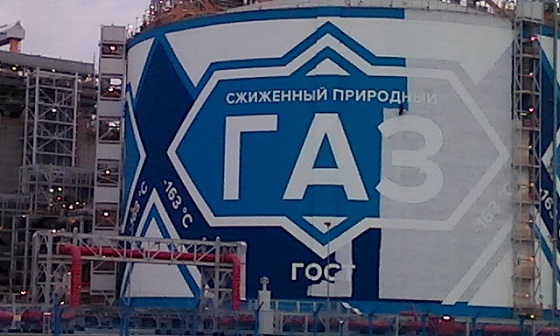Located in the port town of Sabetta in the Yamalo-Nenets Autonomous District, Yamal LNG is a massive liquified natural gas (LNG) complex with a total annual capacity of 18.1 million tons (16.5 million metric tons). According to its website, the LNG complex is situated is “a wild, remote region that is frozen for seven to nine months a year and where winter temperatures can drop as low as -50 °C [-58 °F].”
Despite these conditions — or perhaps even because of them — Yamal LNG launched an international art contest in April 2017. Visual artists, graphic designers, and architects were charged with redesigning four LNG storage tanks that would be used at a future Yamal LNG plant.
That June, Taisiya Spirina from StreetArt Company won the contest with her proposal to decorate the tanks as cans of sguschenka. Packaged in iconic blue-and-white tins,
sguschenka is a sticky-sweet condensed milk that's popular in Russia. The connection between sguschenka and LNG may not be obvious, as the former is a delectable treat and the latter is a mixture of unwholesome ingredients such as methane. But as Spirina rhetorically asked in her winning submission, “What is liquified natural gas, if not condensed gas?”
Working Under a Midnight Sun
O3 Group is a Moscow-based protective coating manufacturer and applicator with extensive experience working with assets in demanding conditions and environments. This made them a natural choice to both provide and apply anticorrosion coatings and passive fire protection solutions for various Yamal LNG facilities, which they had done successfully since 2015 using in-house staff.
The person responsible for creating the Yamal LNG art contest was Gulnaz Harisova, marketing manager at O3-Engineering, which is the application division of the O3 Group. Harisova supervised all aspects of the contest from selecting the materials to interacting with the artists. Securing the material and coatings technologies fell to Leonid Belotserkovsky, sales director at O3-Engineering.

Once Spirina’s design was selected, the next step was for O3-Engineering to paint her mural in the challenging Arctic climate. O3-Engineering began work on the first tank of the project on July 25, 2018, which was a logical start date given that July is on average the warmest month of the year in the region. Yet despite working during the relatively temperate summer months, the period in which the 10-person O3-Engineering crew could complete its work was still severely limited. “The crew had just four weeks, because September weather conditions become inappropriate for painting work,” said Harisova.
Along with high winds and frigid temperatures, the O3-Engineering crew also worked under a midnight sun, a natural phenomenon that occurs during the summer mounts in the north Artic Circle in which the sun remains visible for a full 24 hours. Therefore, the crew was committed to finishing the mural before the start of September, when temperatures begin to plunge to 0 °C (32 °F) and below.
Another potential challenge O3-Engineering faced was that the LNG storage tank they painted needed to be kept operational throughout the project. As a result, work performed in the simultaneous operations (SIMPOS) zone was undertaken with increased security measures and fire precautions in place. Using 3M masks, respirators, and filters, the crew worked in accordance with Occupational Safety and Health Assessment Series (OSHAS) 18001: 2007, a British Standard that regulates occupational health and safety management.
Painting by Numbers
The O3-Enginering crew painted the sguschenka mural on the first LNG storage tank, which had a total surface area of 113,021 square feet (10,500.0 m2). Given the size and scale of the tank, a considerable amount of planning and coordination was required to faithfully execute Spirina’s artistic vision.
According to Harisova and Belotserkovsky, the surface of the LNG tank was divided into four segments, with crew workers working on the segments simultaneously and in rotation. Working without lifting equipment, crew members used steeplejacks and other climbing gear to ascend the 269-foot (82.2 m) wide, 141-foot (43.1 m) tall tank.
I n the first stage, the crew hydroblasted the tank’s concrete surface with a Contracor DBS-200 RCS abrasive blasting machine to eliminate cement “milk” from the concrete surface. The blasting removed laitance, or the weak top layer of cement and aggregate fines on the concrete surface. Belotserkovsky said that the surface prep standard the crew achieved was GOST1 A6,
“which means that the concrete pores had to be opened, and cement milk had to be eliminated. A certain roughness was achieved by this to enhance the adhesion of subsequent coats.” The crew then moved to the second stage, in which they applied a TEKNOPAINT 0078 primer coat with Wagner airless sprayers at an approximate rate of 1 liter per 7 square meters (0.26 gal per 0.65 m2). Belotserkovsky said that temperature differences can cause small asperities or cavities to fill with water and damage the coating, which was why the crew primed the concrete to prevent water saturation and the clogging of concrete pores.
n the first stage, the crew hydroblasted the tank’s concrete surface with a Contracor DBS-200 RCS abrasive blasting machine to eliminate cement “milk” from the concrete surface. The blasting removed laitance, or the weak top layer of cement and aggregate fines on the concrete surface. Belotserkovsky said that the surface prep standard the crew achieved was GOST1 A6,
“which means that the concrete pores had to be opened, and cement milk had to be eliminated. A certain roughness was achieved by this to enhance the adhesion of subsequent coats.” The crew then moved to the second stage, in which they applied a TEKNOPAINT 0078 primer coat with Wagner airless sprayers at an approximate rate of 1 liter per 7 square meters (0.26 gal per 0.65 m2). Belotserkovsky said that temperature differences can cause small asperities or cavities to fill with water and damage the coating, which was why the crew primed the concrete to prevent water saturation and the clogging of concrete pores.
Once the surface was fully prepped, the crew proceeded to stage three, which was to make preliminary markings on the LNG tank surface with theodolites. These precision instruments are used for surveying and measuring angles, which allowed the crew members to draw guidelines over the course of several days. In the fourth and final stage, they painted within those guidelines by applying a basecoat at roughly 0.125 mm (4.9 mils), along with a topcoat of equal thickness.
In select areas, the crew switched from sprayers to rollers due to the “intricate nature of painting the mural on the LNG tank,” Belotserkovsky explained. Thus, the inner areas of the mural were sprayed, while borders were applied using rollers. Both used TEKNOPAINT 0078 and 0078-01 acrylic paints from Teknos. Their ability to withstand sunlight and weathering, along with mechanical and abrasion resistance, makes those coatings well suited for industrial applications, according to the manufacturer.
An Artist’s Work Is Never Done
After 28 days, the first tank of the SGUSCHENKA (Condensed Milk) Project was completed on August 22, 2018 — thus making it the largest art project ever completed in the Arctic. O3 Group plans to continue the massive murals projects on the remaining three Yamal LNG storage tanks that, according to Belotserkovsky, is scheduled to being on June 10, 2019 and end on August 30, 2019. That means O3-Engineering may very well break its own art project record.
“The project was full of challenges because it was our first mural,” said Harisova. “It was a good start toward building a track record in mural painting.”
Editor’s note: This project won 2nd place for this project in CoatingsPro’s 2019 Contractor Awards Program under the Industrial Concrete category.
Reference
1 GOST is an acronym for gosudarstvennyy standart, which translates in English to “state standard.”
